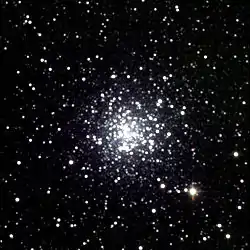| M9 | |
|---|---|
 Messier 9, from 2MASS | |
| Observation data (J2000 epoch) | |
| Class | VIII |
| Constellation | Ophiuchus |
| Right ascension | 17h 19m 11.78s[1] |
| Declination | -18° 30′ 58.5″[1] |
| Distance | 25.8 kly (7.9 kpc) |
| Apparent magnitude (V) | +8.42[1] |
| Apparent dimensions (V) | 12′.0 |
| Physical characteristics | |
| Mass | kg ( M) |
| Radius | 45 ly |
| Other designations | NGC 6333[1] |
Messier 9 or M9 (also designated NGC 6333) is a w:globular cluster in the w:constellation of w:Ophiuchus. It was discovered by w:Charles Messier in w:1764.
M9 is one of the nearer globular clusters to the center of the w:Milky Way Galaxy with a distance of around 5,500 w:light-years. Its distance from w:Earth is 25,800 light-years.
The total w:luminosity of this cluster is around 120,000 times that of the w:Sun, the w:absolute magnitude being -8.04. The brightest individual w:stars in M9 are of w:apparent magnitude 13.5, making them visible in moderately sized w:telescopes. There have been 13 w:variable stars found in M9.
Nearby, at about 80' to the northeast of M9 is the dimmer globular cluster w:NGC 6356, while at about 80' to the southeast is the globular w:NGC 6342.
External links
References
- 1 2 3 4 "SIMBAD Astronomical Database". Results for NGC 6333. http://simbad.u-strasbg.fr/Simbad. Retrieved 2006-11-15.
| |||||